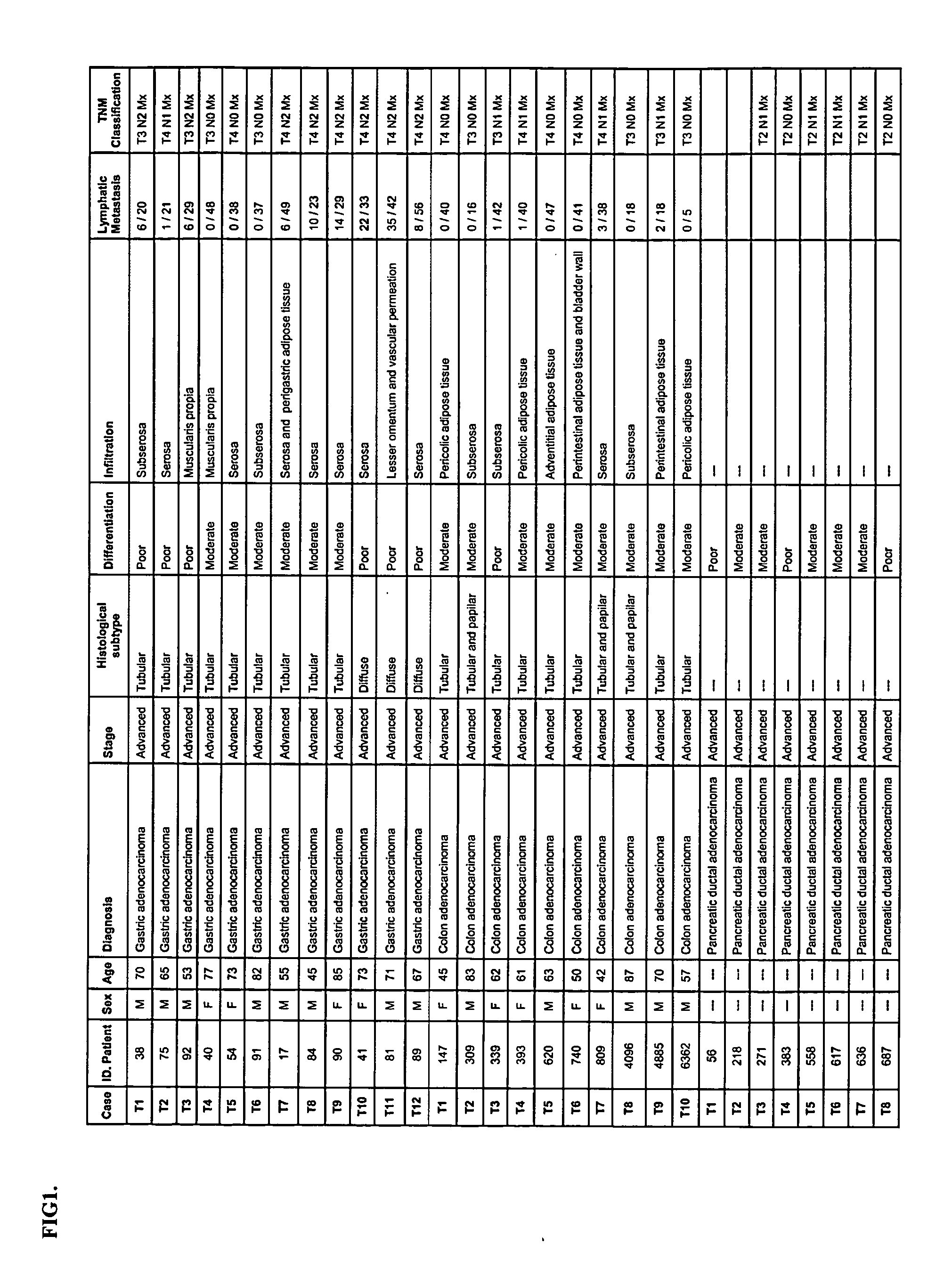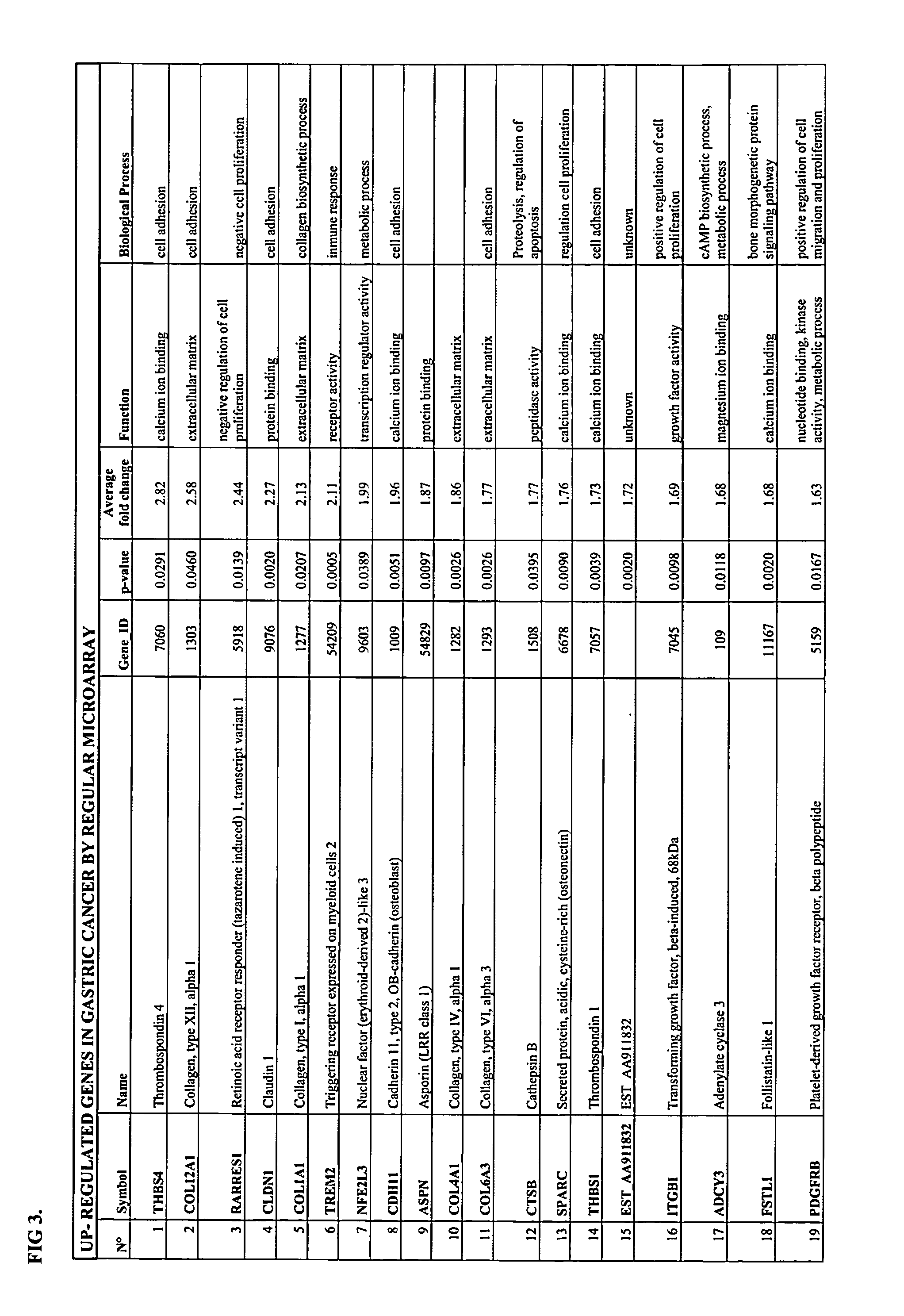Novel genes and uses thereof, expression profile of colon, gastric and pancreatic cancer
a technology of new genes and uses, applied in chemical libraries, combinational chemistry, enzymes, etc., can solve the problem of low survival rate of five years
- Summary
- Abstract
- Description
- Claims
- Application Information
AI Technical Summary
Benefits of technology
Problems solved by technology
Method used
Image
Examples
example 1
[0062]In order to clarify gastric carcinogenesis, a pairing analysis was performed among the 12 samples studied through both strategies. 119 differentially expressed genes were identified from the analysis of the regular microarray strategy. 81 corresponded to up-regulated genes and 38 to down-regulated genes. In the SSH-microarray strategy, a total of 149 differentially expressed genes were identified. Of that number, 59 genes corresponded to up-regulated and 90 genes to down-regulated genes. Both results were statistically significant (p<0.05). FIGS. 3 and 4 show the differential genes obtained from each strategy, including the fold change in the Tumor-Adjacent (T / A) ratio, the statistical significance (p-value) as well as the function and the biological process each gene is involved in.
[0063]In order to validate the information obtained from the regular microarray strategy, 25 selected genes were validated by quantitative real-time PCR. 19 corresponded to up-regulated genes (THY1...
example 2
Differentially Expressed Genes in Colon Cancer
[0067]The pairing analysis was made with 10 cases studied through both strategies for the purpose of identifying differentially expressed genes. 103 genes were identified with a differential expression from the direct strategy. 80 of these genes were up-regulated in cancer tissue as compared to their adjacent tissue counterpart, while 23 genes were downregulated in cancer tissue compared to adjacent non-cancerous tissue. 70 differentially expressed genes were identified using the SSH-microarray strategy, 43 genes being up-regulated and 27 down-regulated. The statistical significance of the results of the first analysis corresponds to a p-value below 0.05, while the p-value for the results of the second analysis was below 0.005. The differential genes obtained in each strategy are shown in FIG. 5 and FIG. 6. The fold change values (tumor / adjacent ratio), statistical significance (p-value) and a function and biological process representati...
example 3
Differentially Expressed Genes in Pancreatic Adenocarcinoma
[0074]A pairing analysis was performed on 8 malignant tissues and their respective adjacent non-tumoral tissues in order to identify differentially expressed genes. 450 differentially expressed genes were identified as a result of the analysis of the direct microarray strategy. Of them, 335 corresponded to up-regulated genes and 115 to down-regulated genes with a statistical significance below 0.01%.
[0075]FIG. 7 shows the differential genes obtained using the regular microarray-strategy. The fold change of the tumor / adjacent ratio (T / A) and the statistical significance (p-value) are included.
[0076]16 genes were selected in order to validate the data obtained through the regular microarray strategy (SPARC, PDGFRB, TREM2, BHLHE40, TOP2A, CALU, SBNO2, PMEPA1, IGFBP5, CTSK, CDH11, COL4A1, TGFBI, PCK2, SNAI2 and FN1), which were quantified using real-time PCR.
[0077]The differential expression was confirmed in 14 genes (p<0.05) an...
PUM
| Property | Measurement | Unit |
|---|---|---|
| Bioavailability | aaaaa | aaaaa |
Abstract
Description
Claims
Application Information
 Login to View More
Login to View More - R&D
- Intellectual Property
- Life Sciences
- Materials
- Tech Scout
- Unparalleled Data Quality
- Higher Quality Content
- 60% Fewer Hallucinations
Browse by: Latest US Patents, China's latest patents, Technical Efficacy Thesaurus, Application Domain, Technology Topic, Popular Technical Reports.
© 2025 PatSnap. All rights reserved.Legal|Privacy policy|Modern Slavery Act Transparency Statement|Sitemap|About US| Contact US: help@patsnap.com



